 ... ...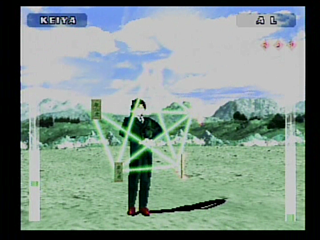
In the overcrowded marketplace of one-on-one fighting games, is there room for one with a "pick up and play" experience? Imagine no need to memorize which buttons are used for strong, weak, and medium punches or kicks. Imagine no need to learn elaborate keypad sequences for special moves that are different for every character. Now imagine this scenario being played out in 3D graphics with 10 anime archetypes and a typically incoherent fighting game plot, and you've just imagined Evil Zone.
Evil Zone chronicles the exploits of 9 warriors who are out to destroy an evil goddess named Ihadulca, who is confined in a dimension known as the "Evil Zone". No matter which warrior you choose to play as, the controls are pretty much the same. The attack he/she executes depends on the distance he/she is from your opponent and what direction on the keypad you are holding at the time. In the developer's most profoundly defiant design feature, all attacks are performed with just one controller button. Pressing this button will facilitate normal punches and kicks when in close range, and automatically shoot projectiles when far away. Pressing it while simultaneously holding a direction key will unleash one of several special moves. There is also a single button for blocking.
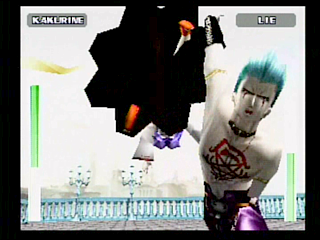 ... ...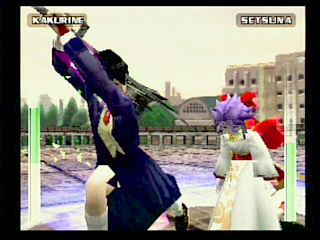
Though the idea is simple, figuring out how to time attacks and blocks accordingly to outwit the CPU opponents can be surprisingly complex. Blocking too much or incorrectly can leave you wide open to being captured or hit with other attacks that will still take effect. I quickly learned that a combination of stunning and capturing your opponent when far away, and using a close-range special move when they're invading your personal space will get you through about 75% of the time. The other 25% relies on improvisation, knowing your character's moveset really well, and a tad of luck. (Capturing, by the way, is a super move in which a character is debilitated by a magic circle and then helplessly assaulted for several seconds in a spectacularly overdone animation display.)
If you are losing a fight badly, there is a chance to even the score and come out on top. By holding the attack button down, you can charge up a meter congruent with your life meter to stock up to three ultimate moves. The lower your life meter, the faster you can charge this up. If an opponent is hit with an ultimate move, they could lose up to half their life meter instantly.
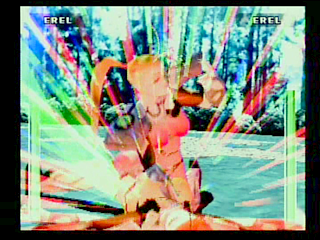 ... ...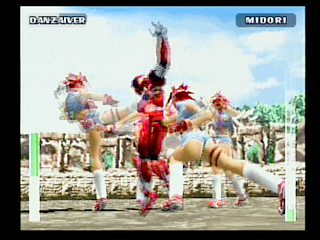
The CPU's AI on the Easy setting is anemic, but you might find it necessary to play on this mode to acclimate to the game's mechanics. Once you bump the difficulty up to Normal, the CPU will start spamming attacks at a rate that a human could not possibly achieve. The CPU even has the ability to fire projectiles and charge up its capture move at the same time, which is not an option for the human player. Though this seems rather cheap, it's not uncommon amongst fighting games, and there are ways to overcome it. Sometimes, though, you might just get lucky and win because the CPU decides to stop spamming for no apparent reason. On the Hard setting, it is more difficult to hit the CPU with ultimate moves, so you can't rely on it as much to win.
The Achilles Heel of this system is that every character feels similar and while some are easier to win with than others, there isn't as great of a dynamic between them as there is (for example) between playing as Haohmaru and playing as Wan Fu in Samurai Shodown. This generates a feeling of monotony after awhile that diminishes interest in finishing the game on every setting with every character.
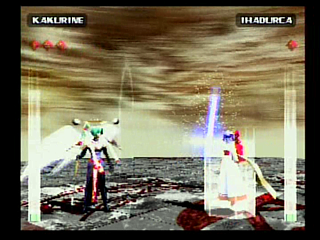 ... ...
Strangely enough, the final boss, a goddess in a dominatrix getup with giant angel wings, becomes easier to beat with practice to the point that she's more manageable than the one or two opponents directly before her. It seems the CPU doesn't spam with her as much, even on harder settings, and her moves are somewhat easier to predict and counter. (If she "Summons Flames" for example, that's your cue to capture her.) She wasn't a bad final boss the first few times I encountered her, but in the long run, she was no M. Bison or Amakusa.
The story details are rather sketchy and would be completely irrelevant, except that the game includes a story mode that attempts to make light of its situation... an attempt that could only be described as "half-hearted" at best. The matches in story mode begin with the selected character talking about his/her upcoming fights as though they are episodes of a TV show - a gimmick that feels pointless and doesn't really work. Some characters' stories, like Linedwell Rainrix, have hardly any details at all, some are completely nonsensical (Danzaiver, Gally, Erel), and Setsuna's storyline can be summed up as, "Setsuna! Karin! Setsuna! Karin! Setsuna! Karin!"
I will give brownie points for Keiya's story, in which he acts as a self-help guru to the other characters, including the final boss. I got a chuckle or two out of that one, but it made me wish that they had taken the anime parody angle a little farther in other areas, instead of generally being indistinguishable from what it's trying to satirize.
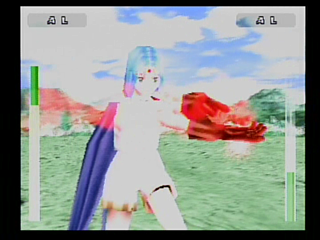 ... ...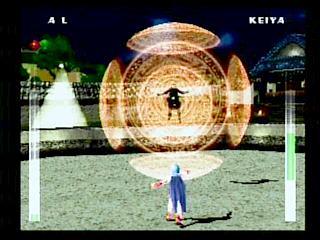
The graphics have that standard "Playstation" look, but they are extremely colorful and many special moves are displayed with elaborate animation sequences from varying camera angles. This makes them addicting to watch, even if some are a smidgen too long (Danzaiver's "Lock On, Seingreed!") Though the character designs are based on generic anime archetypes (cool-headed guy in a suit, big guy with a big sword, blonde buxom bimbo, effeminate male, schoolgirl in uniform with panty shots galore, the sentai hero, the Billy Idol rip-off, etc.), they were drawn by the same company responsible for Tenchi Muyo. Being a fan of that series, I felt comfortable with their familiarity. Oddly enough, the role of spiky-haired martial artist is filled by a female (Midori) instead of the usual male, although her resemblance to Crono of Chrono Trigger is uncannily strange.
Much of the game's soundtrack is outstanding, though I had to listen to it for awhile before I truly started appreciating it, and it has a few low spots. The ending credits song seemed like it was trying to outdo "I am the Wind" from Castlevania: Symphony of the Night with its "smooth jazz" style and Midori's theme is a hopeless rip-off of Molly Hatchet's "Flirting With Disaster" (or maybe Boston's "Smokin'".) Aside from that, the dynamic mix of jazz, pop, electric guitar, and symphonic scores keeps things energized and every song is fitting to its respective character (an over-the-top sentai hero needs an over-the-top heroic anthem, right?)
 ... ...
I can understand why Evil Zone could be disappointing to someone who has had a lot of experience playing more complex fighting games, but it convinced me that I wasn't entirely against the idea of a "pick up and play" game, either. No, it isn't great, and it may not engage you for as long as others in the genre might, but if the thought of memorizing convoluted key combinations for 10+ characters sways you from other fighters, Evil Zone could ease your worries. And unlike some fighting games I've played that were terrible from the start, this one is good up until you lose interest in it.
Score: 3/5
|